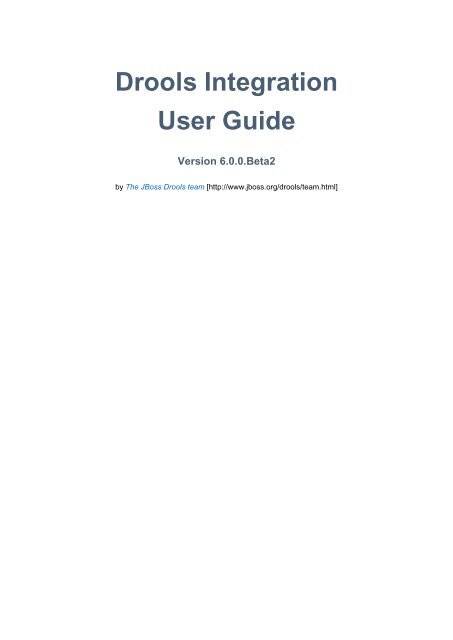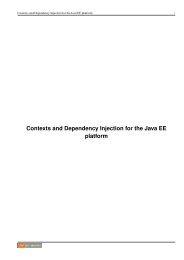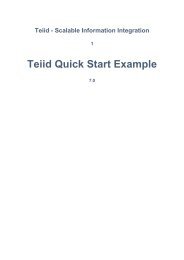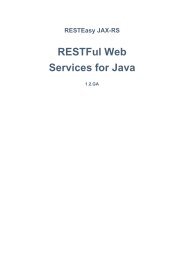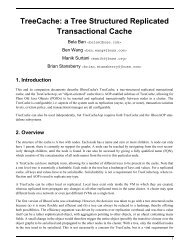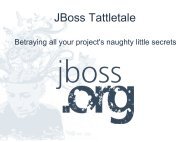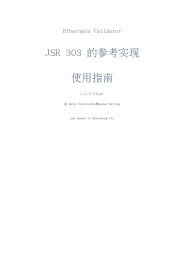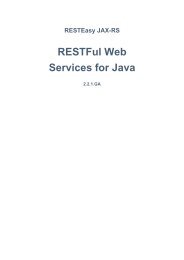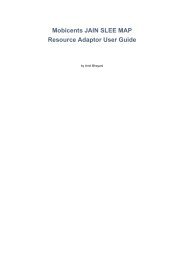Drools Integration User Guide - JBoss
Drools Integration User Guide - JBoss
Drools Integration User Guide - JBoss
Create successful ePaper yourself
Turn your PDF publications into a flip-book with our unique Google optimized e-Paper software.
<strong>Drools</strong> <strong>Integration</strong><br />
<strong>User</strong> <strong>Guide</strong><br />
Version 6.0.0.Beta2<br />
by The <strong>JBoss</strong> <strong>Drools</strong> team [http://www.jboss.org/drools/team.html]
......................................................................................................................................... v<br />
1. Apache Camel <strong>Integration</strong> ........................................................................................... 1<br />
1.1. Camel ................................................................................................................ 1<br />
2. Spring <strong>Integration</strong> ........................................................................................................ 5<br />
2.1. <strong>Integration</strong> with <strong>Drools</strong> Expert .............................................................................. 5<br />
2.1.1. Define a Resource ................................................................................... 5<br />
2.1.2. Event Listeners ...................................................................................... 10<br />
2.2. <strong>Integration</strong> with jBPM Human Task .................................................................... 16<br />
2.2.1. How to configure Spring with jBPM Human task ....................................... 16<br />
3. <strong>Drools</strong> Camel Server ................................................................................................. 19<br />
3.1. Introduction ....................................................................................................... 19<br />
3.2. Deployment ...................................................................................................... 19<br />
3.3. Configuration .................................................................................................... 19<br />
3.3.1. REST/Camel Services configuration ........................................................ 19<br />
4. <strong>Drools</strong> Commands ..................................................................................................... 25<br />
4.1. API ................................................................................................................... 25<br />
4.1.1. XStream ................................................................................................ 25<br />
4.1.2. JSON .................................................................................................... 25<br />
4.1.3. JAXB ..................................................................................................... 25<br />
4.2. Commands supported ....................................................................................... 26<br />
4.2.1. BatchExecutionCommand ....................................................................... 28<br />
4.2.2. InsertObjectCommand ............................................................................ 29<br />
4.2.3. RetractCommand ................................................................................... 31<br />
4.2.4. ModifyCommand .................................................................................... 32<br />
4.2.5. GetObjectCommand ............................................................................... 33<br />
4.2.6. InsertElementsCommand ........................................................................ 34<br />
4.2.7. FireAllRulesCommand ............................................................................ 36<br />
4.2.8. StartProcessCommand ........................................................................... 37<br />
4.2.9. SignalEventCommand ............................................................................ 39<br />
4.2.10. CompleteWorkItemCommand ................................................................ 40<br />
4.2.11. AbortWorkItemCommand ...................................................................... 41<br />
4.2.12. QueryCommand ................................................................................... 42<br />
4.2.13. SetGlobalCommand .............................................................................. 43<br />
4.2.14. GetGlobalCommand ............................................................................. 45<br />
4.2.15. GetObjectsCommand ............................................................................ 46<br />
5. OSGi <strong>Integration</strong> ........................................................................................................ 49<br />
6. JMX monitoring with RHQ/JON ................................................................................. 53<br />
6.1. Introduction ....................................................................................................... 53<br />
6.1.1. Enabling JMX monitoring in a <strong>Drools</strong> application ...................................... 53<br />
6.1.2. Installing and running the RHQ/JON plugin .............................................. 53<br />
iii
Chapter 1.<br />
Chapter 1. Apache Camel<br />
<strong>Integration</strong><br />
1.1. Camel<br />
Camel provides a light weight bus framework for getting information into and out of <strong>Drools</strong>.<br />
<strong>Drools</strong> introduces two elements to make easy integration.<br />
• <strong>Drools</strong> Policy<br />
Augments any JAXB or XStream data loaders. For JAXB it adds drools related paths ot the<br />
contextpath, for XStream it adds custom converters and aliases for <strong>Drools</strong> classes. It also<br />
handles setting the ClassLoader to the targeted ksession.<br />
• <strong>Drools</strong> Endpoint<br />
Executes the payload against the specified drools session<br />
<strong>Drools</strong> can be configured like any normal camel component, but notice the policy that wraps the<br />
drools related segments. This will route all payloads to ksession1<br />
Example 1.1. <strong>Drools</strong> EndPoint configured with the CXFRS producer<br />
<br />
<br />
<br />
<br />
<br />
<br />
<br />
<br />
<br />
<br />
It is possible to not specify the session in the drools endpoint uri, and instead "multiplex" based on<br />
an attribute or header. In this example the policy will check either the header field "<strong>Drools</strong>Lookup"<br />
for the named session to execute and if that isn't specified it'll check the "lookup" attribute on the<br />
incoming payload. It then attempts to "lookup" the session from the execution-node context and<br />
execute against it.<br />
1
Chapter 1. Apache Camel Integ...<br />
Example 1.2. <strong>Drools</strong> EndPoint configured with the CXFRS producer<br />
<br />
<br />
<br />
<br />
<br />
<br />
<br />
<br />
<br />
<br />
Example 1.3. Java Code to execute against Route from a Spring and Camel<br />
Context<br />
public class MyTest extends CamelSpringTestSupport {<br />
@Override<br />
protected AbstractXmlApplicationContext createApplicationContext() {<br />
return new ClassPathXmlApplicationContext("org/drools/camel/component/<br />
CxfRsSpring.xml");<br />
}<br />
public void test1() throws Exception {<br />
String cmd = "";<br />
cmd += "\n";<br />
cmd += " \n";<br />
cmd += " \n";<br />
cmd += "<br />
salaboy\n";<br />
cmd += " \n";<br />
cmd += " \n";<br />
cmd += " \n";<br />
cmd += "\n";<br />
Object object =<br />
this.context.createProducerTemplate().requestBody("direct://client", cmd);<br />
System.out.println( object );<br />
}<br />
The following urls show sample script examples for jaxb, xstream and json marshalling using:<br />
• http://fisheye.jboss.org/browse/<strong>JBoss</strong>Rules/trunk/drools-camel/src/test/resources/org/drools/<br />
camel/component/jaxb.mvt?r=HEAD<br />
2
Camel<br />
• http://fisheye.jboss.org/browse/<strong>JBoss</strong>Rules/trunk/drools-camel/src/test/resources/org/drools/<br />
camel/component/jaxb.mvt?r=HEAD<br />
• http://fisheye.jboss.org/browse/<strong>JBoss</strong>Rules/trunk/drools-camel/src/test/resources/org/drools/<br />
camel/component/xstream.mvt?r=HEAD<br />
3
Chapter 2.<br />
Chapter 2. Spring <strong>Integration</strong><br />
2.1. <strong>Integration</strong> with <strong>Drools</strong> Expert<br />
In this section we will explain the drools namespace.<br />
2.1.1. Define a Resource<br />
Execution nodes are a context to register ksessions and kbases against for lookup.<br />
2.1.1.1. 's parameters as attributes:<br />
Table 2.1.<br />
Attribute Description Required<br />
id<br />
Bean's id is the name to be<br />
reference from other beans.<br />
Yes<br />
2.1.1.2. 's parameters as attributes:<br />
Table 2.2.<br />
Attribute Description Required<br />
id<br />
source<br />
type<br />
Bean's id is the name to be<br />
reference from other beans.<br />
The path to the file containing<br />
the actual resource.<br />
Type of the Resource<br />
as is defined in class<br />
ResourceType.<br />
Yes, but can be omitted when<br />
this tag is nested.<br />
Yes<br />
No, default to DRL<br />
2.1.1.3. 's parameters as nested elements:<br />
When configuring a decision table resource you can nest a tag to<br />
configure the resource.<br />
Table 2.3.<br />
Attribute Description Required<br />
input-type<br />
worksheet-name<br />
Decision Table input type:<br />
XLS or CSV<br />
The worksheet name to be<br />
used in the when using an<br />
XLS<br />
No<br />
No<br />
5
Chapter 2. Spring <strong>Integration</strong><br />
Example 2.1. resource definition example<br />
<br />
<br />
<br />
2.1.1.4. Define a KnowledgeBase<br />
2.1.1.4.1. 's parameters as attributes:<br />
Table 2.4.<br />
Attribute Description Required<br />
id<br />
node<br />
Bean's id is the name to be<br />
referenced from other beans.<br />
Execution-Node context to<br />
register the kbase with<br />
Yes<br />
no<br />
2.1.1.4.2. 's parameters as nested elements:<br />
A Knowledge Base has a 0..n resources. Has two nested elements, resources and configurations.<br />
Those resources can be inner elements or references, using the "ref" attribute.<br />
Example 2.2. kbase definition example<br />
<br />
<br />
<br />
<br />
<br />
<br />
><br />
Define a Resource<br />
<br />
<br />
<br />
<br />
<br />
• advanced-process-rule-integration<br />
• enabled = true : false<br />
• multithread<br />
• enabled = true : false<br />
• max-threads = 1..n<br />
• mbeans<br />
• enabled = true : false<br />
• event-processing-mode<br />
• mode = STREAM : CLOUD<br />
• accumulate-functions<br />
• accumulate-function 0..n<br />
• name = String<br />
• ref = String<br />
• evaluators<br />
• evaluator 0..n<br />
• name = String<br />
• ref = String<br />
• assert-behavior<br />
• mode = IDENTITY : EQUALITY<br />
Figure 2.1. Knowledge Base Configuration Options<br />
7
Chapter 2. Spring <strong>Integration</strong><br />
2.1.1.5. Define KnowledgeSessions<br />
2.1.1.5.1. 's parameters as attributes:<br />
Table 2.5.<br />
Attribute Description Required<br />
id<br />
type<br />
Bean's id is the name to be<br />
referenced from other beans.<br />
is the session stateful or<br />
stateless?<br />
Yes<br />
Yes<br />
name No; defaults to id when<br />
omitted.<br />
node<br />
listeners<br />
Execution-Node context to<br />
register the ksession with<br />
Specifies the reference to the<br />
event listeners group (see<br />
'Defining a Group of listeners'<br />
section below).<br />
no<br />
no<br />
Example 2.3. ksession definition example<br />
<br />
<br />
Define a Resource<br />
<br />
• keep-reference<br />
• enabled = true : false<br />
• clock-type<br />
• type = REALTIME : PSEUDO<br />
• jpa-persistence<br />
• transaction-manager<br />
• ref = String<br />
• entity-manager-factory<br />
• ref = String<br />
Figure 2.2. Knowledge Session Configuration Options<br />
• insert-object<br />
• ref = String (optional)<br />
• Anonymous bean<br />
• set-global<br />
• identifier = String (required)<br />
• reg = String (optiona)<br />
• Anonymous bean<br />
• fire-all-rules<br />
• max : n<br />
• fire-until-halt<br />
• start-process<br />
• parameter<br />
• identifier = String (required)<br />
• ref = String (optional)<br />
9
Chapter 2. Spring <strong>Integration</strong><br />
• Anonymous bean<br />
• signal-event<br />
• ref = String (optional)<br />
• event-type = String (required)<br />
• process-instance-id =n (optional)<br />
Figure 2.3. Initialization Batch Commands<br />
Example 2.4. ksession JPA configuration example<br />
<br />
<br />
<br />
><br />
Event Listeners<br />
The drools-spring module allows you to configure these listeners to KnowledgeSessions<br />
using XML tags. These tags have identical names as the actual listener<br />
interfaces i.e., , and<br />
.<br />
drools-spring provides features to define the listeners as standalone (individual) listeners and also<br />
to define them as a group.<br />
2.1.2.1. Defining Stand alone Listeners:<br />
2.1.2.1.1. Attributes:<br />
Table 2.6.<br />
Attribute Required Description<br />
ref No A reference to another<br />
declared bean.<br />
Example 2.5. Listener configuration example - using a bean:ref.<br />
<br />
<br />
<br />
<br />
<br />
<br />
<br />
<br />
<br />
<br />
<br />
<br />
<br />
<br />
2.1.2.1.2. Nested Elements:<br />
• bean<br />
11
Chapter 2. Spring <strong>Integration</strong><br />
• class = String<br />
• name = String (optional)<br />
Example 2.6. Listener configuration example - using nested bean.<br />
<br />
<br />
<br />
<br />
<br />
<br />
<br />
<br />
<br />
<br />
<br />
<br />
<br />
<br />
<br />
<br />
<br />
2.1.2.1.3. Empty Tag : Declaration with no 'ref' and without a nested bean<br />
When a listener is defined without a reference to a implementing bean and does not contain<br />
a nested bean, the underlying implementation adds the<br />
Debug version of the listener defined in the API.<br />
The debug listeners print the corresponding Event toString message to System.err.<br />
Example 2.7. Listener configuration example - defaulting to the debug<br />
versions provided by the Knowledge-API .<br />
<br />
<br />
12
Event Listeners<br />
<br />
<br />
<br />
<br />
<br />
<br />
<br />
<br />
<br />
2.1.2.1.4. Mix and Match of different declaration styles<br />
The drools-spring module allows you to mix and match the different declarative styles within the<br />
same KnowledgeSession. The below sample provides more clarity.<br />
Example 2.8. Listener configuration example - mix and match of 'ref'/nestedbean/empty<br />
styles.<br />
<br />
<br />
<br />
<br />
<br />
<br />
<br />
Chapter 2. Spring <strong>Integration</strong><br />
<br />
2.1.2.1.5. Defining multiple listeners of the same type<br />
It is also valid to define multiple beans of the same event listener types for a KnowledgeSession.<br />
Example 2.9. Listener configuration example - multiple listeners of the same<br />
type.<br />
<br />
<br />
<br />
<br />
<br />
<br />
<br />
Event Listeners<br />
2.1.2.2.2. Nested Elements:<br />
• drools:agendaEventListener...<br />
• drools:workingMemoryEventListener...<br />
• drools:processEventListener...<br />
Note<br />
The above mentioned child elements can be declared in any order. Only one<br />
declaration of each type is allowed in a group.<br />
2.1.2.2.3. Example:<br />
Example 2.10. Group of listeners - example<br />
<br />
<br />
<br />
<br />
<br />
<br />
<br />
<br />
<br />
<br />
<br />
<br />
<br />
<br />
<br />
<br />
<br />
<br />
15
Chapter 2. Spring <strong>Integration</strong><br />
2.2. <strong>Integration</strong> with jBPM Human Task<br />
This chapter describes the infrastructure used when configuring a human task server with Spring<br />
as well as a little bit about the infrastructure used when doing this.<br />
2.2.1. How to configure Spring with jBPM Human task<br />
The jBPM human task server can be configured to use Spring persistence. Example 2.11,<br />
“Configuring Human Task with Spring” is an example of this which uses local transactions and<br />
Spring's thread-safe EntityManager proxy.<br />
The following diagram shows the dependency graph used in Example 2.11, “Configuring Human<br />
Task with Spring”.<br />
Figure 2.4. Spring Human Task integration injection dependencies<br />
A TaskService instance is dependent on two other bean types: a drools<br />
SystemEventListener bean as well as a TaskSessionSpringFactoryImpl bean. The<br />
TaskSessionSpringFactoryImpl bean is howerver not injected into the TaskService bean<br />
because this would cause a circular dependency. To solve this problem, when the TaskService<br />
bean is injected into the TaskSessionSpringFactoryImpl bean, the setter method used secretly<br />
injects the TaskSessionSpringFactoryImpl instance back into the TaskService bean and<br />
initializes the TaskService bean as well.<br />
The TaskSessionSpringFactoryImpl bean is responsible for creating all the internal instances<br />
in human task that deal with transactions and persistence context management. Besides a<br />
TaskService instance, this bean also requires a transaction manager and a persistence context<br />
to be injected. Specifically, it requires an instance of a HumanTaskSpringTransactionManager<br />
16
How to configure Spring with jBPM Human task<br />
bean (as a transaction manager) and an instance of a SharedEntityManagerBean bean (as a<br />
persistence context instance).<br />
We also use some of the standard Spring beans in order to configure persistence: there's a<br />
bean to hold the EntityManagerFactory instance as well as the SharedEntityManagerBean<br />
instance. The SharedEntityManagerBean provides a shared, thread-safe proxy for the actual<br />
EntityManager.<br />
The HumanTaskSpringTransactionManager bean serves as a wrapper around the Spring<br />
transaction manager, in this case the JpaTransactionManager. An instance of a<br />
JpaTransactionManager bean is also instantiated because of this.<br />
Example 2.11. Configuring Human Task with Spring<br />
<br />
<br />
<br />
<br />
<br />
<br />
<br />
<br />
<br />
<br />
<br />
<br />
<br />
<br />
Chapter 2. Spring <strong>Integration</strong><br />
<br />
<br />
<br />
Chapter 3.<br />
Chapter 3. <strong>Drools</strong> Camel Server<br />
3.1. Introduction<br />
The drools camel server (drools-camel-server) module is a war which you can deploy to execute<br />
KnowledgeBases remotely for any sort of client application. This is not limited to JVM application<br />
clients, but any technology that can use HTTP, through a REST interface. This version of the<br />
execution server supports stateless and stateful sessions in a native way.<br />
3.2. Deployment<br />
<strong>Drools</strong> Camel Server is a war file, which can be deployed in a application server (such as <strong>JBoss</strong><br />
AS). As the service is stateless, it is possible to have have as many of these services deployed<br />
as you need to serve the client load. Deploy on <strong>JBoss</strong> AS 4.x / Tomcat 6.x works out-of-the-box,<br />
instead some external dependencies must be added and the configuration must be changed to<br />
be deployed in <strong>JBoss</strong> AS 5<br />
3.3. Configuration<br />
Inside the war file you will find a few XML configuration files.<br />
• beans.xml<br />
• Skeleton xml that imports knowledge-services.xml and camel-server.xml<br />
• camel-server.xml<br />
• Configures CXF endpoints with Camel Routes<br />
• Came Routes pipeline messages to various configured knowledge services<br />
• knowledge-services.xml<br />
• Various Knowledge Bases and Sessions<br />
• camel-client.xml<br />
• Sample camel client showing how to send and receive a message<br />
• Used by "out of the box" test.jsp<br />
3.3.1. REST/Camel Services configuration<br />
The next step is configure the services that are going to be exposed through drools-server. You<br />
can modify this configuration in camel-server.xml file.<br />
<br />
Chapter 3. <strong>Drools</strong> Camel Server<br />
xmlns:xsi="http://www.w3.org/2001/XMLSchema-instance"<br />
xmlns:cxf="http://camel.apache.org/schema/cxf"<br />
xmlns:jaxrs="http://cxf.apache.org/jaxrs"<br />
xsi:schemaLocation="<br />
http://www.springframework.org/schema/beans http://www.springframework.org/<br />
schema/beans/spring-beans-2.5.xsd<br />
http://camel.apache.org/schema/cxf http://camel.apache.org/schema/cxf/camelcxf.xsd<br />
http://cxf.apache.org/jaxrs http://cxf.apache.org/schemas/jaxrs.xsd<br />
http://camel.apache.org/schema/spring http://camel.apache.org/schema/spring/<br />
camel-spring.xsd"><br />
<br />
<br />
<br />
<br />
<br />
<br />
<br />
<br />
<br />
<br />
<br />
<br />
<br />
<br />
20
REST/Camel Services configuration<br />
<br />
<br />
<br />
<br />
<br />
<br />
<br />
<br />
<br />
<br />
3.3.1.1. RESTful service endpoint creation<br />
In the next xml snippet code we are creating a RESTful (JAX-RS) endpoint bound to /kservice/<br />
rest address and using org.drools.jax.rs.CommandExecutorImpl as the service implementer. This<br />
class is only used to instantiate the service endpoint because all the internal implementation is<br />
managed by Camel, and you can see in the source file that the exposed execute service must<br />
be never called.<br />
Also a JAX-RS Provider is provided to determine if the message transported can be processed<br />
in this service endpoint.<br />
<br />
<br />
<br />
<br />
<br />
Ideally this configuration doesn't need to be modified, at least the Service Class and the JAX-<br />
RS Provider, but you can add more endpoints associated to different addresses to use them in<br />
other Camel Routes.<br />
After all this initial configuration, you can start config your own Knowledge Services.<br />
3.3.1.2. Camel <strong>Drools</strong> Policy & Context creation<br />
<strong>Drools</strong>Policy is used to add <strong>Drools</strong> support in Camel, basically what it does is to add interceptors<br />
into the camel route to create Camel Processors on the fly and modify the internal navigation<br />
route. If you want to have SOAP support you need to create your custom <strong>Drools</strong> Policy, but it's<br />
going to be added in the next release.<br />
But you don’t need to know more internal details, only instantiate this bean:<br />
21
Chapter 3. <strong>Drools</strong> Camel Server<br />
<br />
The next is create the camel route that will have the responsibility to execute the commands<br />
sent through JAX-RS. Basically we create a route definition associated with the JAX-RS<br />
definition as the data input, the camel policy to be used and inside the “execution route” or<br />
ProcessorDefinitions. As you can see, we set XStream as the marshaller/unmarshaller and the<br />
drools execution route definition<br />
<br />
<br />
<br />
<br />
<br />
<br />
<br />
<br />
<br />
<br />
The drools endpoint creation has the next arguments<br />
<br />
1. Execution Node identifier that is registered in the CamelContext<br />
2. Knowledge Session identifier that was registered in the Execution Node with identifier {1}<br />
Both parameters are configured in knowledge-services.xml file.<br />
3.3.1.3. Knowledge Services configuration<br />
The next step is create the Knowledge Sessions that you are going to use.<br />
<br />
<br />
22
REST/Camel Services configuration<br />
<br />
<br />
<br />
<br />
<br />
<br />
<br />
<br />
The execution-node is a context or registered kbases and ksessions, here kbase1 and ksession1<br />
are planed in the node1 context. The kbase itself consists of 2 knowledge definitions, a drl and an<br />
xsd. The Spring documentation contains a lot more information on configuring these knowledge<br />
services.<br />
3.3.1.4. Test<br />
With drools-server war unzipped you should be able to see a test.jsp and run it. This example just<br />
executes a simple "echo" type application. It sends a message to the rule server that pre-appends<br />
the word "echo" to the front and sends it back. By default the message is "Hello World", different<br />
messages can be passed using the url parameter msg - test.jsp?msg="My Custom Message".<br />
Under the hood the jsp invokes the Test.java class, this then calls out to Camel which is where<br />
the meet happens. The camel-client.xml defines the client with just a few lines of xml:<br />
<br />
<br />
<br />
<br />
<br />
<br />
<br />
<br />
"direct://kservice" is just a named hook, allowing java to grab a reference and push data into<br />
it. In this example the data is already in xml, so we don't need to add any DataFormat's to do<br />
the marshalling. The <strong>Drools</strong>Policy adds some smarts to the route and you'll see it used on the<br />
server side too. If JAXB or XStream were used, it would inject custom paths and converters, it<br />
can also set the ClassLoader too on the server side, on the client side it automatically unwraps<br />
the Response object.<br />
The rule itself can be found here: test.drl. Notice the type Message is declared part of the drl and<br />
is thus not present on the Classpath.<br />
23
Chapter 3. <strong>Drools</strong> Camel Server<br />
declare Message<br />
end<br />
text : String<br />
rule "echo" dialect "mvel"<br />
when<br />
$m : Message();<br />
then<br />
$m.text = "echo:" + $m.text;<br />
end<br />
24
Chapter 4.<br />
Chapter 4. <strong>Drools</strong> Commands<br />
4.1. API<br />
XML marshalling/unmarshalling of the <strong>Drools</strong> Commands requires the use of special classes,<br />
which are going to be described in the following sections.<br />
The following urls show sample script examples for jaxb, xstream and json marshalling using:<br />
• http://fisheye.jboss.org/browse/<strong>JBoss</strong>Rules/trunk/drools-camel/src/test/resources/org/drools/<br />
camel/component/jaxb.mvt?r=HEAD<br />
• http://fisheye.jboss.org/browse/<strong>JBoss</strong>Rules/trunk/drools-camel/src/test/resources/org/drools/<br />
camel/component/jaxb.mvt?r=HEAD<br />
• http://fisheye.jboss.org/browse/<strong>JBoss</strong>Rules/trunk/drools-camel/src/test/resources/org/drools/<br />
camel/component/xstream.mvt?r=HEAD<br />
4.1.1. XStream<br />
To use the XStream commands marshaller you need to use the <strong>Drools</strong>HelperProvider to obtain<br />
an XStream instance. We need to use this because it has the commands converters registered.<br />
• Marshalling<br />
BatchExecutionHelperProviderImpl.newXStreamMarshaller().toXML(command);<br />
• Unmarshalling<br />
BatchExecutionHelperProviderImpl.newXStreamMarshaller().fromXML(xml)<br />
4.1.2. JSON<br />
JSON API to marshalling/unmarshalling is similar to XStream API:<br />
• Marshalling<br />
BatchExecutionHelper.newJSonMarshaller().toXML(command);<br />
• Unmarshalling<br />
BatchExecutionHelper.newJSonMarshaller().fromXML(xml)<br />
4.1.3. JAXB<br />
There are two options for using JAXB, you can define your model in an XSD file or you can have<br />
a POJO model. In both cases you have to declare your model inside JAXBContext, and in order<br />
to do that you need to use <strong>Drools</strong> Helper classes. Once you have the JAXBContext you need to<br />
create the Unmarshaller/Marshaller as needed.<br />
25
Chapter 4. <strong>Drools</strong> Commands<br />
4.1.3.1. Using an XSD file to define the model<br />
With your model defined in a XSD file you need to have a KnowledgeBase that has your XSD<br />
model added as a resource.<br />
To do this, the XSD file must be added as a XSD ResourceType into the KnowledgeBuilder. Finally<br />
you can create the JAXBContext using the KnowledgeBase created with the KnowledgeBuilder<br />
Options xjcOpts = new Options();<br />
xjcOpts.setSchemaLanguage(Language.XMLSCHEMA);<br />
JaxbConfiguration jaxbConfiguration = KnowledgeBuilderFactory.newJaxbConfiguration( xjcOpts, "x<br />
kbuilder.add(ResourceFactory.newClassPathResource("person.xsd", getClass()), ResourceType.XSD,<br />
KnowledgeBase kbase = kbuilder.newKnowledgeBase();<br />
List classesName = new ArrayList();<br />
classesName.add("org.drools.compiler.test.Person");<br />
JAXBContext jaxbContext = KnowledgeBuilderHelper.newJAXBContext(classesName.toArray(new String[<br />
4.1.3.2. Using a POJO model<br />
In this case you need to use <strong>Drools</strong>JaxbHelperProviderImpl to create the JAXBContext. This class<br />
has two parameters:<br />
1. classNames: A List with the canonical name of the classes that you want to use in the<br />
marshalling/unmarshalling process.<br />
2. properties: JAXB custom properties<br />
List classNames = new ArrayList();<br />
classNames.add("org.drools.compiler.test.Person");<br />
JAXBContext jaxbContext = <strong>Drools</strong>JaxbHelperProviderImpl.create<strong>Drools</strong>JaxbContext(classNames, null<br />
Marshaller marshaller = jaxbContext.createMarshaller();<br />
4.2. Commands supported<br />
Currently, the following commands are supported:<br />
• BatchExecutionCommand<br />
• InsertObjectCommand<br />
• RetractCommand<br />
26
Commands supported<br />
• ModifyCommand<br />
• GetObjectCommand<br />
• InsertElementsCommand<br />
• FireAllRulesCommand<br />
• StartProcessCommand<br />
• SignalEventCommand<br />
• CompleteWorkItemCommand<br />
• AbortWorkItemCommand<br />
• QueryCommand<br />
• SetGlobalCommand<br />
• GetGlobalCommand<br />
• GetObjectsCommand<br />
Note<br />
In the next snippets code we are going to use a POJO<br />
org.drools.compiler.test.Person that has two fields<br />
• name: String<br />
• age: Integer<br />
Note<br />
In the next examples, to marshall the commands we have used the next snippet<br />
codes:<br />
• XStream<br />
String xml = BatchExecutionHelper.newXStreamMarshaller().toXML(command);<br />
• JSON<br />
String xml = BatchExecutionHelper.newJSonMarshaller().toXML(command);<br />
27
Chapter 4. <strong>Drools</strong> Commands<br />
• JAXB<br />
Marshaller marshaller = jaxbContext.createMarshaller();<br />
StringWriter xml = new StringWriter();<br />
marshaller.setProperty(Marshaller.JAXB_FORMATTED_OUTPUT, true);<br />
marshaller.marshal(command, xml);<br />
4.2.1. BatchExecutionCommand<br />
• Description: The command that contains a list of commands, which will be sent and executed.<br />
• Attributes<br />
Table 4.1. BatchExecutionCommand attributes<br />
Name Description required<br />
lookup<br />
commands<br />
Sets the knowledge session<br />
id on which the commands<br />
are going to be executed<br />
List of commands to be<br />
executed<br />
true<br />
false<br />
• Command creation<br />
BatchExecutionCommand command = new BatchExecutionCommand();<br />
command.setLookup("ksession1");<br />
InsertObjectCommand insertObjectCommand = new InsertObjectCommand(new Person("john", 25));<br />
FireAllRulesCommand fireAllRulesCommand = new FireAllRulesCommand();<br />
command.getCommands().add(insertObjectCommand);<br />
command.getCommands().add(fireAllRulesCommand);<br />
• XML output<br />
• XStream<br />
<br />
<br />
<br />
john<br />
25<br />
28
InsertObjectCommand<br />
<br />
<br />
<br />
<br />
• JSON<br />
{"batch-execution":{"lookup":"ksession1","commands":[{"insert":{"object":<br />
{"org.drools.compiler.test.Person":{"name":"john","age":25}}}},{"fire-allrules":""}]}}<br />
• JAXB<br />
<br />
<br />
<br />
<br />
25<br />
john<br />
<br />
<br />
<br />
<br />
4.2.2. InsertObjectCommand<br />
• Description: Insert an object in the knowledge session.<br />
• Attributes<br />
Table 4.2. InsertObjectCommand attributes<br />
Name Description required<br />
object The object to be inserted true<br />
outIdentifier<br />
Id to identify the FactHandle<br />
created in the object insertion<br />
and added to the execution<br />
results<br />
false<br />
29
Chapter 4. <strong>Drools</strong> Commands<br />
Name Description required<br />
returnObject<br />
Boolean to establish if the<br />
object must be returned in<br />
the execution results. Default<br />
value: true<br />
false<br />
entryPoint Entrypoint for the insertion false<br />
• Command creation<br />
List cmds = ArrayList();<br />
Command insertObjectCommand = CommandFactory.newInsert(new Person("john", 25), "john", false,<br />
cmds.add( insertObjectCommand );<br />
BatchExecutionCommand command = CommandFactory.createBatchExecution(cmds, "ksession1" );<br />
• XML output<br />
• XStream<br />
• JSON<br />
<br />
<br />
<br />
john<br />
25<br />
<br />
<br />
<br />
{"batch-execution":{"lookup":"ksession1","commands":{"insert":{"entrypoint":"my<br />
stream", "out-identifier":"john","return-object":false,"object":<br />
{"org.drools.compiler.test.Person":{"name":"john","age":25}}}}}}<br />
• JAXB<br />
<br />
<br />
30
RetractCommand<br />
<br />
<br />
25<br />
john<br />
<br />
<br />
<br />
4.2.3. RetractCommand<br />
• Description: Retract an object from the knowledge session.<br />
• Attributes<br />
Table 4.3. RetractCommand attributes<br />
Name Description required<br />
handle<br />
The FactHandle associated to<br />
the object to be retracted<br />
true<br />
• Command creation: we have two options, with the same output result:<br />
1. Create the Fact Handle from a string<br />
BatchExecutionCommand command = new BatchExecutionCommand();<br />
command.setLookup("ksession1");<br />
RetractCommand retractCommand = new RetractCommand();<br />
retractCommand.setFactHandleFromString("123:234:345:456:567");<br />
command.getCommands().add(retractCommand);<br />
2. Set the Fact Handle that you received when the object was inserted<br />
BatchExecutionCommand command = new BatchExecutionCommand();<br />
command.setLookup("ksession1");<br />
RetractCommand retractCommand = new RetractCommand(factHandle);<br />
command.getCommands().add(retractCommand);<br />
• XML output<br />
• XStream<br />
31
Chapter 4. <strong>Drools</strong> Commands<br />
<br />
<br />
<br />
• JSON<br />
{"batch-execution":{"lookup":"ksession1","commands":{"retract":{"facthandle":"0:234:345:456:567"}}}}<br />
• JAXB<br />
<br />
<br />
<br />
<br />
4.2.4. ModifyCommand<br />
• Description: Allows you to modify a previously inserted object in the knowledge session.<br />
• Attributes<br />
Table 4.4. ModifyCommand attributes<br />
Name Description required<br />
handle<br />
The FactHandle associated to<br />
the object to be retracted<br />
true<br />
setters List of setters object's<br />
modifications<br />
true<br />
• Command creation<br />
BatchExecutionCommand command = new BatchExecutionCommand();<br />
command.setLookup("ksession1");<br />
ModifyCommand modifyCommand = new ModifyCommand();<br />
modifyCommand.setFactHandleFromString("123:234:345:456:567");<br />
List setters = new ArrayList();<br />
setters.add(new SetterImpl("age", "30"));<br />
modifyCommand.setSetters(setters);<br />
32
GetObjectCommand<br />
command.getCommands().add(modifyCommand);<br />
• XML output<br />
• XStream<br />
<br />
<br />
<br />
<br />
<br />
• JSON<br />
{"batch-execution":{"lookup":"ksession1","commands":{"modify":{"facthandle":"0:234:345:456:567","setters":{"accessor":"age","value":30}}}}}<br />
• JAXB<br />
<br />
<br />
<br />
<br />
<br />
<br />
4.2.5. GetObjectCommand<br />
• Description: Used to get an object from a knowledge session<br />
• Attributes<br />
Table 4.5. GetObjectCommand attributes<br />
Name Description required<br />
factHandle<br />
outIdentifier<br />
The FactHandle associated to<br />
the object to be retracted<br />
Id to identify the FactHandle<br />
created in the object insertion<br />
true<br />
false<br />
33
Chapter 4. <strong>Drools</strong> Commands<br />
Name Description required<br />
and added to the execution<br />
results<br />
• Command creation<br />
BatchExecutionCommand command = new BatchExecutionCommand();<br />
command.setLookup("ksession1");<br />
GetObjectCommand getObjectCommand = new GetObjectCommand();<br />
getObjectCommand.setFactHandleFromString("123:234:345:456:567");<br />
getObjectCommand.setOutIdentifier("john");<br />
command.getCommands().add(getObjectCommand);<br />
• XML output<br />
• XStream<br />
<br />
<br />
<br />
• JSON<br />
{"batch-execution":{"lookup":"ksession1","commands":{"get-object":{"facthandle":"0:234:345:456:567","out-identifier":"john"}}}}<br />
• JAXB<br />
<br />
<br />
<br />
<br />
4.2.6. InsertElementsCommand<br />
• Description: Used to insert a list of objects.<br />
• Attributes<br />
34
InsertElementsCommand<br />
Table 4.6. InsertElementsCommand attributes<br />
Name Description required<br />
objects<br />
outIdentifier<br />
returnObject<br />
The list of objects to be<br />
inserted on the knowledge<br />
session<br />
Id to identify the FactHandle<br />
created in the object insertion<br />
and added to the execution<br />
results<br />
Boolean to establish if the<br />
object must be returned in<br />
the execution results. Default<br />
value: true<br />
true<br />
false<br />
false<br />
entryPoint Entrypoint for the insertion false<br />
• Command creation<br />
List cmds = ArrayList();<br />
List objects = new ArrayList();<br />
objects.add(new Person("john", 25));<br />
objects.add(new Person("sarah", 35));<br />
Command insertElementsCommand = CommandFactory.newInsertElements( objects );<br />
cmds.add( insertElementsCommand );<br />
BatchExecutionCommand command = CommandFactory.createBatchExecution(cmds, "ksession1" );<br />
• XML output<br />
• XStream<br />
<br />
<br />
<br />
john<br />
25<br />
<br />
<br />
sarah<br />
35<br />
<br />
35
Chapter 4. <strong>Drools</strong> Commands<br />
<br />
<br />
• JSON<br />
{"batch-execution":{"lookup":"ksession1","commands":{"insert-elements":<br />
{"objects":[{"containedObject":<br />
{"@class":"org.drools.compiler.test.Person","name":"john","age":25}},<br />
{"containedObject":{"@class":"Person","name":"sarah","age":35}}]}}}}<br />
• JAXB<br />
<br />
<br />
<br />
<br />
<br />
25<br />
john<br />
<br />
<br />
35<br />
sarah<br />
<br />
<br />
<br />
<br />
4.2.7. FireAllRulesCommand<br />
• Description: Allow execution of the rules activations created.<br />
• Attributes<br />
Table 4.7. FireAllRulesCommand attributes<br />
Name Description required<br />
max<br />
The max number of rules<br />
activations to be executed.<br />
default is -1 and will not put<br />
any restriction on execution<br />
false<br />
36
StartProcessCommand<br />
Name Description required<br />
outIdentifier<br />
agendaFilter<br />
Add the number of rules<br />
activations fired on the<br />
execution results<br />
Allow the rules execution<br />
using an Agenda Filter<br />
false<br />
false<br />
• Command creation<br />
BatchExecutionCommand command = new BatchExecutionCommand();<br />
command.setLookup("ksession1");<br />
FireAllRulesCommand fireAllRulesCommand = new FireAllRulesCommand();<br />
fireAllRulesCommand.setMax(10);<br />
fireAllRulesCommand.setOutIdentifier("firedActivations");<br />
command.getCommands().add(fireAllRulesCommand);<br />
• XML output<br />
• XStream<br />
<br />
<br />
<br />
• JSON<br />
{"batch-execution":{"lookup":"ksession1","commands":{"fire-all-rules":<br />
{"max":10,"out-identifier":"firedActivations"}}}}<br />
• JAXB<br />
<br />
<br />
<br />
<br />
4.2.8. StartProcessCommand<br />
37
Chapter 4. <strong>Drools</strong> Commands<br />
• Description: Allows you to start a process using the ID. Also you can pass parameters and initial<br />
data to be inserted.<br />
• Attributes<br />
Table 4.8. StartProcessCommand attributes<br />
Name Description required<br />
processId<br />
parameters<br />
data<br />
The ID of the process to be<br />
started<br />
A Map to<br />
pass parameters in the<br />
process startup<br />
A list of objects to be inserted<br />
in the knowledge session<br />
before the process startup<br />
true<br />
false<br />
false<br />
• Command creation<br />
BatchExecutionCommand command = new BatchExecutionCommand();<br />
command.setLookup("ksession1");<br />
StartProcessCommand startProcessCommand = new StartProcessCommand();<br />
startProcessCommand.setProcessId("org.drools.task.processOne");<br />
command.getCommands().add(startProcessCommand);<br />
• XML output<br />
• XStream<br />
<br />
<br />
<br />
• JSON<br />
{"batch-execution":{"lookup":"ksession1","commands":{"start-process":<br />
{"process-id":"org.drools.task.processOne"}}}}<br />
• JAXB<br />
<br />
<br />
38
SignalEventCommand<br />
<br />
<br />
<br />
<br />
4.2.9. SignalEventCommand<br />
• Description: Send a signal event.<br />
• Attributes<br />
Table 4.9. SignalEventCommand attributes<br />
Name Description required<br />
event-type<br />
processInstanceId<br />
event<br />
true<br />
false<br />
false<br />
• Command creation<br />
BatchExecutionCommand command = new BatchExecutionCommand();<br />
command.setLookup("ksession1");<br />
SignalEventCommand signalEventCommand = new SignalEventCommand();<br />
signalEventCommand.setProcessInstanceId(1001);<br />
signalEventCommand.setEventType("start");<br />
signalEventCommand.setEvent(new Person("john", 25));<br />
command.getCommands().add(signalEventCommand);<br />
• XML output<br />
• XStream<br />
<br />
<br />
<br />
john<br />
25<br />
<br />
<br />
<br />
• JSON<br />
39
Chapter 4. <strong>Drools</strong> Commands<br />
{"batch-execution":{"lookup":"ksession1","commands":{"signal-event":<br />
{"process-instance-id":1001,"@event-type":"start","eventtype":"start","object":{"org.drools.pipeline.camel.Person":<br />
{"name":"john","age":25}}}}}}<br />
• JAXB<br />
<br />
<br />
<br />
<br />
25<br />
john<br />
<br />
<br />
<br />
4.2.10. CompleteWorkItemCommand<br />
• Description: Allows you to complete a WorkItem.<br />
• Attributes<br />
Table 4.10. CompleteWorkItemCommand attributes<br />
Name Description required<br />
workItemId<br />
results<br />
The ID of the WorkItem to be<br />
completed<br />
true<br />
false<br />
• Command creation<br />
BatchExecutionCommand command = new BatchExecutionCommand();<br />
command.setLookup("ksession1");<br />
CompleteWorkItemCommand completeWorkItemCommand = new CompleteWorkItemCommand();<br />
completeWorkItemCommand.setWorkItemId(1001);<br />
command.getCommands().add(completeWorkItemCommand);<br />
• XML output<br />
40
AbortWorkItemCommand<br />
• XStream<br />
<br />
<br />
<br />
• JSON<br />
{"batch-execution":{"lookup":"ksession1","commands":{"complete-work-item":<br />
{"id":1001}}}}<br />
• JAXB<br />
<br />
<br />
<br />
<br />
4.2.11. AbortWorkItemCommand<br />
• Description: Allows you abort an WorkItem. The same as<br />
session.getWorkItemManager().abortWorkItem(workItemId)<br />
• Attributes<br />
Table 4.11. AbortWorkItemCommand attributes<br />
Name Description required<br />
workItemId<br />
The ID of the WorkItem to be<br />
completed<br />
true<br />
• Command creation<br />
BatchExecutionCommand command = new BatchExecutionCommand();<br />
command.setLookup("ksession1");<br />
AbortWorkItemCommand abortWorkItemCommand = new AbortWorkItemCommand();<br />
abortWorkItemCommand.setWorkItemId(1001);<br />
41
Chapter 4. <strong>Drools</strong> Commands<br />
command.getCommands().add(abortWorkItemCommand);<br />
• XML output<br />
• XStream<br />
<br />
<br />
<br />
• JSON<br />
{"batch-execution":{"lookup":"ksession1","commands":{"abort-work-item":<br />
{"id":1001}}}}<br />
• JAXB<br />
<br />
<br />
<br />
<br />
4.2.12. QueryCommand<br />
• Description: Executes a query defined in knowledge base.<br />
• Attributes<br />
Table 4.12. QueryCommand attributes<br />
Name Description required<br />
name The query name true<br />
outIdentifier<br />
The identifier of the query<br />
results. The query results are<br />
going to be added in the<br />
execution results with this<br />
identifier<br />
false<br />
42
SetGlobalCommand<br />
Name Description required<br />
arguments<br />
A list of objects to be passed<br />
as a query parameter<br />
false<br />
• Command creation<br />
BatchExecutionCommand command = new BatchExecutionCommand();<br />
command.setLookup("ksession1");<br />
QueryCommand queryCommand = new QueryCommand();<br />
queryCommand.setName("persons");<br />
queryCommand.setOutIdentifier("persons");<br />
command.getCommands().add(queryCommand);<br />
• XML output<br />
• XStream<br />
<br />
<br />
<br />
• JSON<br />
{"batch-execution":{"lookup":"ksession1","commands":{"query":{"outidentifier":"persons","name":"persons"}}}}<br />
• JAXB<br />
<br />
<br />
<br />
<br />
4.2.13. SetGlobalCommand<br />
• Description: Allows you to set a global.<br />
• Attributes<br />
43
Chapter 4. <strong>Drools</strong> Commands<br />
Table 4.13. SetGlobalCommand attributes<br />
Name Description required<br />
identifier<br />
object<br />
out<br />
outIdentifier<br />
The identifier of the global<br />
defined in the knowledge<br />
base<br />
The object to be set into the<br />
global<br />
A boolean to add, or not,<br />
the set global result into the<br />
execution results<br />
The identifier of the global<br />
execution result<br />
true<br />
false<br />
false<br />
false<br />
• Command creation<br />
BatchExecutionCommand command = new BatchExecutionCommand();<br />
command.setLookup("ksession1");<br />
SetGlobalCommand setGlobalCommand = new SetGlobalCommand();<br />
setGlobalCommand.setIdentifier("helper");<br />
setGlobalCommand.setObject(new Person("kyle", 30));<br />
setGlobalCommand.setOut(true);<br />
setGlobalCommand.setOutIdentifier("output");<br />
command.getCommands().add(setGlobalCommand);<br />
• XML output<br />
• XStream<br />
<br />
<br />
<br />
kyle<br />
30<br />
<br />
<br />
<br />
• JSON<br />
44
GetGlobalCommand<br />
{"batch-execution":{"lookup":"ksession1","commands":{"set-global":<br />
{"identifier":"helper","out-identifier":"output","object":<br />
{"org.drools.compiler.test.Person":{"name":"kyle","age":30}}}}}}<br />
• JAXB<br />
<br />
<br />
<br />
<br />
30<br />
kyle<br />
<br />
<br />
<br />
4.2.14. GetGlobalCommand<br />
• Description: Allows you to get a global previously defined.<br />
• Attributes<br />
Table 4.14. GetGlobalCommand attributes<br />
Name Description required<br />
identifier<br />
outIdentifier<br />
The identifier of the global<br />
defined in the knowledge<br />
base<br />
The identifier to be used in the<br />
execution results<br />
true<br />
false<br />
• Command creation<br />
BatchExecutionCommand command = new BatchExecutionCommand();<br />
command.setLookup("ksession1");<br />
GetGlobalCommand getGlobalCommand = new GetGlobalCommand();<br />
getGlobalCommand.setIdentifier("helper");<br />
getGlobalCommand.setOutIdentifier("helperOutput");<br />
command.getCommands().add(getGlobalCommand);<br />
45
Chapter 4. <strong>Drools</strong> Commands<br />
• XML output<br />
• XStream<br />
<br />
<br />
<br />
• JSON<br />
{"batch-execution":{"lookup":"ksession1","commands":{"get-global":<br />
{"identifier":"helper","out-identifier":"helperOutput"}}}}<br />
• JAXB<br />
<br />
<br />
<br />
<br />
4.2.15. GetObjectsCommand<br />
• Description: Returns all the objects from the current session as a Collection.<br />
• Attributes<br />
Table 4.15. GetObjectsCommand attributes<br />
Name Description required<br />
objectFilter<br />
outIdentifier<br />
An ObjectFilter to filter the<br />
objects returned from the<br />
current session<br />
The identifier to be used in the<br />
execution results<br />
false<br />
false<br />
• Command creation<br />
BatchExecutionCommand command = new BatchExecutionCommand();<br />
46
GetObjectsCommand<br />
command.setLookup("ksession1");<br />
GetObjectsCommand getObjectsCommand = new GetObjectsCommand();<br />
getObjectsCommand.setOutIdentifier("objects");<br />
command.getCommands().add(getObjectsCommand);<br />
• XML output<br />
• XStream<br />
<br />
<br />
<br />
• JSON<br />
{"batch-execution":{"lookup":"ksession1","commands":{"get-objects":{"outidentifier":"objects"}}}}<br />
• JAXB<br />
<br />
<br />
<br />
<br />
47
Chapter 5.<br />
Chapter 5. OSGi <strong>Integration</strong><br />
OSGi is a dynamic module system for declarative services. So what does that mean? Each jar<br />
in OSGi is called a bundle and has it's own ClassLoader. Each bundle specifies the packages it<br />
exports (makes publicly available) and which packages it imports (external dependencies). OSGi<br />
will use this information to wire the ClassLoaders of different bundles together; the key distinction<br />
is you don't specify what bundle you depend on, or have a single monolithic classpath, instead you<br />
specify your package import and version and OSGi attempts to satisfy this from available bundles.<br />
It also supports side by side versioning, so you can have multiple versions of a bundle installed<br />
and it'll wire up the correct one. Further to this Bundles can register services for other bundles to<br />
use. These services need initialisation, which can cause ordering problems - how do you make<br />
sure you don't consume a service before its registered? OSGi has a number of features to help<br />
with service composition and ordering. The two main ones are the programmatic ServiceTracker<br />
and the xml based Declarative Services. There are also other projects that help with this; Spring<br />
DM, iPOJO, Gravity.<br />
Each of the <strong>Drools</strong> factories is now also available as a FactoryService interface. You can either<br />
have OSGi inject those into a pojo, or retrieve them yourself from OSGi.<br />
The following modules should work with OSGi;<br />
• knowledge-api<br />
• drools-core<br />
• drools-compiler<br />
• drools-templates<br />
• drools-decisiontables<br />
The following Services can be located as OSGi Bundles<br />
• KnowledgeBuilderFactoryService<br />
• KnowledgeBaseFactoryService<br />
• ResourceFactoryService<br />
I'll cover injection here. The below example injects the KnowledgeBuilderFactoryService,<br />
KnowledgeBaseFactoryService and ResourceFactoryService into the TestComponent pojo.<br />
Example 5.1. OSGi Declarative Services<br />
<br />
<br />
Chapter 5. OSGi <strong>Integration</strong><br />
unbind="unsetKnowledgeBaseFactoryService"<br />
interface="org.drools.KnowledgeBaseFactoryService"<br />
/><br />
<br />
<br />
<br />
The TestComponent will only be activated when all of the referenced services are<br />
available and injected into the pojo. You'll also notice the "target" attribute for the<br />
KnowledgeBuilderFactoryService. The reason for this is that OSGi DS has no built in way to<br />
declaratively say which optional services must be present to satisfy your component. As a work<br />
around I made any <strong>Drools</strong> service that has optional services set a property if/when the optional<br />
service is available. Filters can then be applied, via the target attribute, to make sure the Service<br />
is in a desired state before consuming it. And that is pretty much it :)<br />
Example 5.2. Basic Rule Compilation<br />
ServiceReference serviceRef =<br />
bundleContext.getServiceReference( ServiceRegistry.class.getName() );<br />
ServiceRegistry registry = (ServiceRegistry)<br />
bundleContext.getService( serviceRef );<br />
KnowledgeBuilderFactoryService knowledgeBuilderFactoryService =<br />
registry.get( KnowledgeBuilderFactoryService.class );<br />
KnowledgeBaseFactoryService knowledgeBaseFactoryService =<br />
registry.get( KnowledgeBaseFactoryService.class );<br />
ResourceFactoryService resourceFactoryService =<br />
registry.get( ResourceFactoryService.class );<br />
KnowledgeBuilderConfiguration kbConf =<br />
knowledgeBuilderFactoryService.newKnowledgeBuilderConfiguration( null,<br />
getClass().getClassLoader() );<br />
KnowledgeBuilder kbuilder =<br />
knowledgeBuilderFactoryService.newKnowledgeBuilder( kbConf );<br />
ResourceFactoryService resource = resourceFactoryService;<br />
kbuilder.add( resource.newByteArrayResource( string.getBytes() ),<br />
50
ResourceType.DRL );<br />
if ( kbuilder.hasErrors() ) {<br />
System.out.println( kbuilder.getErrors() );<br />
throw new RuntimeException( kbuilder.getErrors().toString() );<br />
}<br />
KnowledgeBaseConfiguration kbaseConf =<br />
knowledgeBaseFactoryService.newKnowledgeBaseConfiguration( null,<br />
getClass().getClassLoader() );<br />
KnowledgeBase kbase = knowledgeBaseFactoryService.newKnowledgeBase( kbaseConf );<br />
kbase.addKnowledgePackages( kbuilder.getKnowledgePackages() );<br />
StatefulKnowledgeSession ksession = kbase.newStatefulKnowledgeSession();<br />
Example 5.3. Decision Table Example<br />
ServiceReference serviceRef =<br />
bundleContext.getServiceReference( ServiceRegistry.class.getName() );<br />
ServiceRegistry registry = (ServiceRegistry)<br />
bundleContext.getService( serviceRef );<br />
KnowledgeBuilderFactoryService knowledgeBuilderFactoryService =<br />
registry.get( KnowledgeBuilderFactoryService.class );<br />
KnowledgeBaseFactoryService knowledgeBaseFactoryService =<br />
registry.get( KnowledgeBaseFactoryService.class );<br />
ResourceFactoryService resourceFactoryService =<br />
registry.get( ResourceFactoryService.class );<br />
KnowledgeBaseConfiguration kbaseConf =<br />
knowledgeBaseFactoryService.newKnowledgeBaseConfiguration( null,<br />
getClass().getClassLoader() );<br />
KnowledgeBuilderConfiguration kbConf =<br />
knowledgeBuilderFactoryService.newKnowledgeBuilderConfiguration( null,<br />
getClass().getClassLoader() );<br />
KnowledgeBuilder kbuilder =<br />
knowledgeBuilderFactoryService.newKnowledgeBuilder( kbConf );<br />
kbuilder.add( resourceFactoryService.newClassPathResource( "changeset1Test.xml",<br />
Dummy.class ),<br />
ResourceType.CHANGE_SET );<br />
kbaseConf = knowledgeBaseFactoryService.newKnowledgeBaseConfiguration( null,<br />
51
Chapter 5. OSGi <strong>Integration</strong><br />
getClass().getClassLoader() );<br />
KnowledgeBase kbase = knowledgeBaseFactoryService.newKnowledgeBase( kbaseConf );<br />
kbase.addKnowledgePackages( kbuilder.getKnowledgePackages() );<br />
StatefulKnowledgeSession ksession = kbase.newStatefulKnowledgeSession();<br />
52
Chapter 6.<br />
Chapter 6. JMX monitoring with<br />
RHQ/JON<br />
6.1. Introduction<br />
The <strong>Drools</strong> engine supports runtime monitoring through JMX standard MBeans. These MBeans<br />
expose configuration and metrics data, from live knowledge bases and sessions, to internal details<br />
like rule execution times. Any JMX compatible console can be used to access that data. This<br />
chapter details how to use RHQ/JON to do it, but similar steps can be used for any other console.<br />
6.1.1. Enabling JMX monitoring in a <strong>Drools</strong> application<br />
To enable JMX monitoring in a <strong>Drools</strong> application, it is necessary to enable remote monitoring in<br />
the JVM. There are several tutorials on how to do that in the internet, but we recommend that you<br />
check the documentation of your specific JVM. Using the Oracle/Sun JVM, it can be as simple as<br />
running the engine with a few command line system properties.<br />
For instance, to enable remote monitoring on port 19988 with disabled authentication (should<br />
be only used for tests/demos, as in production authentication should be enabled), just run the<br />
application with the following command line parameters:<br />
-Dcom.sun.management.jmxremote.port=19988 -<br />
Dcom.sun.management.jmxremote.ssl=false -<br />
Dcom.sun.management.jmxremote.authenticate=false<br />
The second step is to enable the <strong>Drools</strong> MBeans. As any <strong>Drools</strong> configuration, that can be done<br />
by setting a system property, or adding the property to a configuration file, or using the API.<br />
To enable it in the command line, use:<br />
-Ddrools.mbeans=enabled<br />
To enable id using the API, use:<br />
KnowledgeBaseConfiguration conf = ...<br />
conf.setOption( MBeansOption.ENABLED );<br />
6.1.2. Installing and running the RHQ/JON plugin<br />
The following sequence of steps can be used to configure JON to monitor a <strong>Drools</strong> application:<br />
53
Chapter 6. JMX monitoring wit...<br />
1. Download the JON server and agent.<br />
2. Download <strong>Drools</strong> plugin included in the "<strong>Drools</strong> and jBPM tools" bundle (http://www.jboss.org/<br />
drools/downloads.html).<br />
3. Install server, agent, and the plugin.<br />
4. Check that the server is running, agent is running and plugin is installed.<br />
5. Execute the drools application [see details in the previous section].<br />
6. On the agent console, type "discovery" command for the agent to find the drools application,<br />
which it will find on port 19988.<br />
7. On JON console, click on auto-discovery queue.<br />
8. Select the JMX Server process that is showing there, running on port 19988.<br />
9. Click import.<br />
10.Click on Resources->servers.<br />
11.Click on the JMX Server.<br />
12.Under JMXServer on the left hand side, you have <strong>Drools</strong> Service.<br />
54


